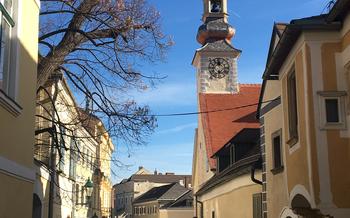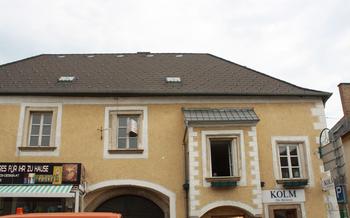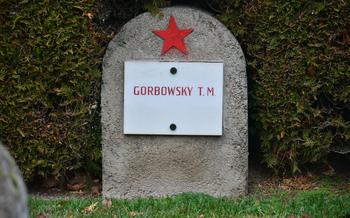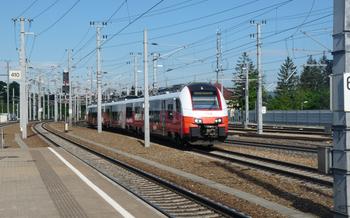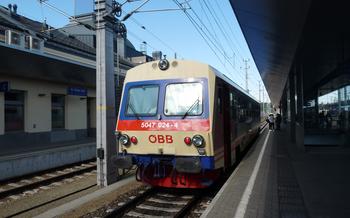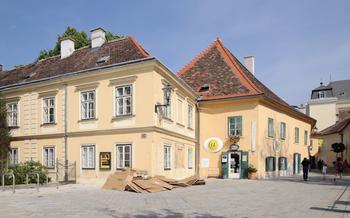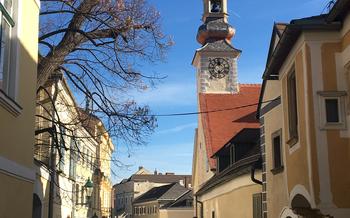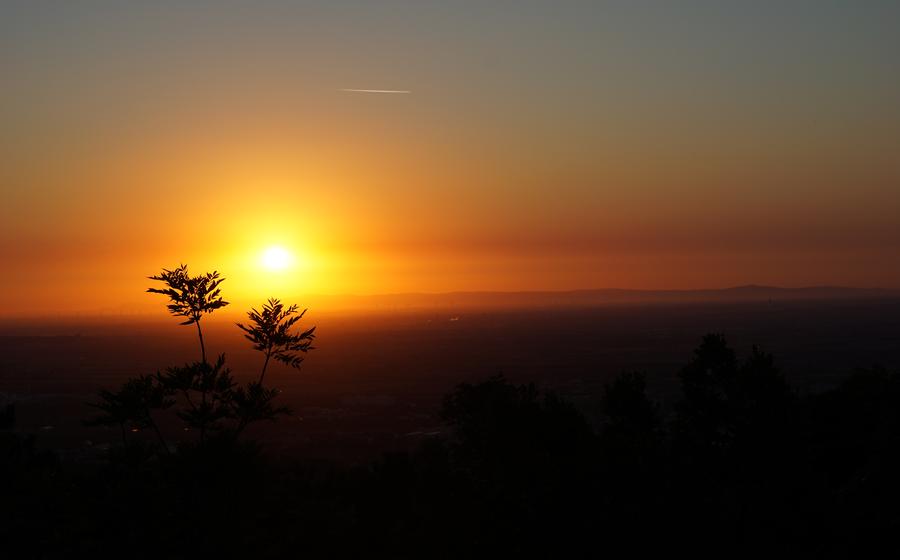
Hundertwasserhaus
- The Hundertwasserhaus in Mödling, Austria: A Unique Architectural Masterpiece
- Exploring the Hundertwasserhaus: A Visual and Sensory Experience
- The Man Behind the Masterpiece: Friedensreich Hundertwasser
- A Walk Through the Hundertwasserhaus: Uncovering Its Secrets
- Mödling: A Town Steeped in History and Charm
- Getting to the Hundertwasserhaus: Convenient Transportation Options
- Capturing the Essence of the Hundertwasserhaus: Photography Tips
- Beyond the Hundertwasserhaus: Exploring Mödling's Art and Culture
- Experiencing Mödling's Natural Beauty: Parks and Hiking Trails
- Insider Tip: Discovering Hidden Gems Around the Hundertwasserhaus
- Accessibility for Visitors with Disabilities: Navigating the Hundertwasserhaus's Unique Features
- Sustainability Initiatives at the Hundertwasserhaus
- Historical Significance of the Hundertwasserhaus
- Insider Tip: Unforgettable Souvenirs and Local Delights
The Hundertwasserhaus in Mödling, Austria: A Unique Architectural Masterpiece
The Hundertwasserhaus in Mödling, Austria, is a captivating architectural marvel designed by the renowned artist Friedensreich Hundertwasser. Completed in 1985, the building stands as a testament to Hundertwasser's unique artistic vision and his commitment to creating structures that harmoniously blend with nature. Its vibrant facade, adorned with colorful mosaics and organic forms, immediately captures the attention of visitors, inviting them to explore its unconventional beauty. Situated in the picturesque town of Mödling, just a short train ride from Vienna, the Hundertwasserhaus has become a cultural landmark and a must-see destination for art enthusiasts and architecture aficionados alike. Its groundbreaking design has significantly contributed to the Austrian art scene, pushing the boundaries of conventional architecture and inspiring a new generation of creative thinkers.
Exploring the Hundertwasserhaus: A Visual and Sensory Experience
The Hundertwasserhaus is not just a building but a living artwork that invites visitors to engage with its unique design elements. The building's facade is a symphony of colors and shapes, with vibrantly painted walls, intricate mosaics, and irregular windows that create a mesmerizing effect. The play of light and shadow on the building's surface adds another dimension to its visual appeal, transforming the structure throughout the day.
Stepping inside the Hundertwasserhaus is like entering a magical world where the boundaries between indoor and outdoor spaces blur. The building features a "forest roof" with lush greenery, creating a sense of harmony with nature. The "tree tenants," trees that grow out of the building's facade, further reinforce this connection. The irregular windows, each with its own unique shape and size, offer captivating views of the surrounding landscape, framing the world outside in unexpected ways.
Visitors can also engage with the building's interactive features, such as water features that cascade down the facade and a spiral staircase that leads to the rooftop terrace. Hidden surprises await those who explore every nook and cranny of the Hundertwasserhaus, rewarding them with unexpected discoveries and insights into the artist's creative mind.
The Man Behind the Masterpiece: Friedensreich Hundertwasser
Behind the vibrant facade of the Hundertwasserhaus lies the creative vision of Friedensreich Hundertwasser, an Austrian artist and architect whose unique style and philosophy left an indelible mark on the world of contemporary art. Born in 1928, Hundertwasser developed a deep connection with nature from an early age, which would later become a defining characteristic of his work. He rejected the rigid lines and uniformity of traditional architecture, advocating instead for organic forms, vibrant colors, and a harmonious blend of nature and human creation.
Hundertwasser's artistic philosophy extended beyond aesthetics. He believed that architecture should not only serve functional purposes but also enhance human well-being and foster a connection with the environment. He incorporated elements of nature into his buildings, such as trees growing on rooftops and colorful mosaics inspired by natural patterns. His work aimed to create spaces that were not just visually appealing but also emotionally uplifting and spiritually enriching.
Hundertwasser's unique approach to architecture gained international recognition, and he became one of the most influential figures in contemporary art. His works can be found in various cities around the world, including Vienna, Barcelona, and Osaka. The Hundertwasserhaus in Mödling stands as a testament to his visionary spirit and remains a beloved landmark that continues to inspire and captivate visitors from all corners of the globe.
A Walk Through the Hundertwasserhaus: Uncovering Its Secrets
Exploring the interior of the Hundertwasserhaus is like embarking on a journey through a whimsical wonderland. Guided tours provide valuable insights into the building's design and symbolism, revealing the stories behind its unique features. Visitors can marvel at the intricately tiled floors, colorful mosaic work, and playful architectural elements that characterize every corner of the building.
The rooftop terrace offers panoramic views of the surrounding town and the distant Vienna skyline, providing a breathtaking perspective on the Hundertwasserhaus's unique position within the urban landscape. Interactive elements, such as water features and a spiral staircase, add to the immersive experience, inviting visitors to engage with the building and discover hidden surprises.
Throughout the Hundertwasserhaus, one can find hidden details and messages embedded in the architecture, waiting to be deciphered. These hidden gems, often inspired by nature or mythology, add depth and intrigue to the building, encouraging visitors to explore every nook and cranny to uncover its secrets.
Mödling: A Town Steeped in History and Charm
Mödling, a picturesque town nestled in the heart of Lower Austria, boasts a rich history dating back to the Middle Ages. Once a regional center of trade and commerce, Mödling retains its medieval charm with narrow cobblestone streets, colorful facades, and historic landmarks.
The town's origins can be traced back to the 11th century when it was mentioned in documents as "Modilinch." Throughout its history, Mödling has played a significant role in the region, serving as a strategic defensive point and a center for cultural and religious activities.
One of Mödling's most prominent landmarks is the Mödling Abbey, a former Benedictine monastery founded in the 12th century. The abbey's impressive architecture and serene atmosphere attract visitors from near and far. Another notable landmark is the Town Hall, a Renaissance-style building that serves as the seat of local government.
Mödling's Pilgrimage Church, dedicated to Our Lady of Sorrows, is a popular destination for pilgrims and art enthusiasts alike. The church's stunning interior, adorned with intricate frescoes and Baroque altars, is a testament to the town's rich artistic heritage.
Beyond its historical significance, Mödling is also renowned for its vibrant cultural scene. The town hosts regular events and festivals throughout the year, showcasing local talent and attracting visitors from across the region. Whether it's a traditional wine festival, a lively music concert, or a colorful art exhibition, there's always something to experience in Mödling.
The town's proximity to Vienna, Austria's vibrant capital, makes it an ideal day trip destination. Visitors can easily hop on a train from Vienna and be in Mödling within minutes, immersing themselves in the town's unique blend of history, culture, and natural beauty.
Getting to the Hundertwasserhaus: Convenient Transportation Options
Reaching the Hundertwasserhaus is a breeze, thanks to its convenient location in the charming town of Mödling, just a short train ride from Vienna. To embark on your artistic journey, simply hop on a train from Vienna's city center and relax as the train whisks you away to Mödling. Trains depart frequently, ensuring a smooth and timely commute.
Upon arriving at Mödling train station, you'll find yourself a mere 10-minute stroll from the Hundertwasserhaus. As you make your way through the town's quaint streets, take a moment to soak in the local atmosphere and admire the surrounding architecture.
For those without rail access, alternative transportation options are readily available. Buses and taxis provide a convenient means of reaching the Hundertwasserhaus, ensuring that everyone can experience this architectural marvel.
To make your journey even smoother, here's a pro tip: plan your visit in advance and check the train schedules to avoid any potential delays. This way, you can arrive at the Hundertwasserhaus with ample time to explore its wonders without feeling rushed.
Capturing the Essence of the Hundertwasserhaus: Photography Tips
The Hundertwasserhaus, with its vibrant colors, intricate details, and unique architectural features, presents a captivating subject for photographers. To capture the essence of this extraordinary building, careful consideration of camera settings, angles, and techniques is essential.
For optimal results, use a wide-angle lens to encompass the building's grand facade and its interplay with the surrounding environment. Experiment with different vantage points to capture the building from various perspectives, highlighting its unique features.
To capture the play of light and shadow on the Hundertwasserhaus's facade, choose the right time of day. Early morning or late afternoon light often produces dramatic shadows that accentuate the building's three-dimensional qualities.
When photographing the building's interior, focus on capturing the intricate details and interactive features that make it so captivating. Experiment with different angles and perspectives to convey the building's unique spatial relationships.
Respect the artist's rights and the privacy of the building's residents when taking photographs. Avoid using flash photography or capturing images of people without their consent.
Beyond the Hundertwasserhaus: Exploring Mödling's Art and Culture
The Hundertwasserhaus is undoubtedly the highlight of Mödling's cultural scene, but the town offers a wealth of other artistic experiences for visitors to explore. The Mödling Museum, housed in a beautifully preserved 16th-century building, showcases the town's rich history, art, and culture. Here, visitors can delve into the region's fascinating past and discover the works of local artists.
For those interested in contemporary art, the Kunsthaus Mödling is a must-visit. This vibrant gallery features a rotating program of exhibitions by renowned Austrian and international artists, showcasing the latest trends and innovations in the art world. The annual Mödling Summer Festival is another highlight of the town's cultural calendar. This lively festival brings the streets of Mödling to life with music, dance, theater, and art installations, creating a vibrant and festive atmosphere.
Whether you're an art enthusiast or simply looking for a fun and enriching cultural experience, Mödling has something to offer everyone. From traditional museums to contemporary galleries and lively festivals, the town's vibrant arts scene is sure to leave a lasting impression.
Experiencing Mödling's Natural Beauty: Parks and Hiking Trails
Beyond the cultural allure of the Hundertwasserhaus and Mödling's art scene, nature enthusiasts will find themselves captivated by the town's stunning surroundings. The nearby Wienerwald (Vienna Woods) beckons with its vast expanse of forests, offering a sanctuary for hikers and nature lovers alike. With trails suitable for all levels, from leisurely strolls to challenging climbs, the Wienerwald provides a refreshing escape into the tranquility of nature.
Closer to town, the Mödlingbach River meanders through a picturesque nature reserve, inviting visitors to embark on serene walks along its banks. The gentle murmur of the river and the diverse wildlife that call the reserve home create a tranquil ambiance, perfect for escaping the hustle and bustle of city life.
For those seeking a fragrant interlude, the Mödling Rose Garden is a must-visit. Bursting into bloom during the summer months, the garden showcases over 10,000 roses, filling the air with their intoxicating scent. Visitors can wander through the colorful displays, admiring the beauty of these delicate flowers and capturing their vibrant hues.
Combining nature exploration with cultural immersion is a breeze in Mödling. The Hundertwasserhaus, with its unique blend of architecture and nature, serves as an ideal starting point for a day of exploration. From there, visitors can easily venture into the Wienerwald, stroll along the Mödlingbach River, or immerse themselves in the fragrant beauty of the Rose Garden, creating a memorable experience that encompasses both the town's artistic and natural wonders.
Insider Tip: Discovering Hidden Gems Around the Hundertwasserhaus
Beyond the Hundertwasserhaus, the town of Mödling and its surroundings offer a wealth of hidden gems waiting to be discovered. Stroll through the medieval town center of Mödling, where charming streets lined with historic buildings transport you back in time. Don't miss the neighboring town of Baden, renowned for its thermal springs and beautiful parks, a perfect place to relax and rejuvenate.
Venture further to Liechtenstein Castle, a stunning Baroque palace surrounded by picturesque gardens, offering a glimpse into the region's rich history. For a taste of local flavors, savor authentic Austrian cuisine at one of Mödling's charming restaurants or cafes. Whether it's the medieval charm of the town center, the tranquility of Baden's thermal springs, the grandeur of Liechtenstein Castle, or the culinary delights of Mödling's restaurants, there's something for everyone to discover beyond the Hundertwasserhaus.
Accessibility for Visitors with Disabilities: Navigating the Hundertwasserhaus's Unique Features
The Hundertwasserhaus is committed to ensuring that visitors of all abilities can enjoy its unique architecture and creative spaces. The building features thoughtful accessibility measures that make it accessible to individuals with disabilities.
Wheelchair-accessible ramps and elevators provide convenient access to different levels of the building, allowing visitors to navigate its intricate design without barriers. Designated parking spaces close to the entrance are available for visitors with disabilities, facilitating their arrival and departure.
To enhance the experience for visitors with visual impairments, audio guides are available, providing detailed descriptions of the building's features, its history, and the artist's vision. The guides are designed to enrich the visit by bringing the building's unique elements to life through vivid narration.
Despite the building's unconventional design, characterized by irregular windows and narrow passages, efforts have been made to ensure that visitors with mobility challenges can navigate the spaces comfortably. Staff members are always ready to assist visitors with any accessibility needs, providing support and guidance throughout their visit.
By incorporating these accessibility features, the Hundertwasserhaus demonstrates its commitment to inclusivity and ensures that everyone can appreciate and engage with the building's artistic and architectural wonders.
Sustainability Initiatives at the Hundertwasserhaus
The Hundertwasserhaus is not only a masterpiece of architecture but also a testament to Friedensreich Hundertwasser's commitment to environmental sustainability. Hundertwasser believed that architecture should be in harmony with nature, and he incorporated several innovative features into the building's design to reduce its environmental impact and promote eco-friendly practices.
One key feature is the building's rainwater harvesting system. Rainwater is collected from the roof and stored in underground cisterns, where it is filtered and used to irrigate the building's green spaces and flush the toilets. This reduces the building's reliance on municipal water supplies and helps to conserve water.
Another sustainable element is the use of solar panels. The building's roof is equipped with solar panels that generate electricity, which is used to power the building's lighting and other electrical systems. This reduces the building's carbon footprint and promotes the use of renewable energy sources.
The building's unique design also contributes to energy efficiency. The irregular shape of the building helps to create natural ventilation, reducing the need for air conditioning. Additionally, the use of natural materials, such as wood and stone, helps to regulate the building's temperature and humidity, creating a more comfortable indoor environment.
Through these innovative features, the Hundertwasserhaus serves as a showcase for sustainable architecture and demonstrates the potential for buildings to have a positive impact on the environment. Hundertwasser's commitment to sustainability continues to inspire contemporary architects and designers, and the building remains a model for eco-friendly construction.
Historical Significance of the Hundertwasserhaus
The Hundertwasserhaus in Mödling, Austria, holds immense historical significance, transcending its status as a unique architectural masterpiece. Its groundbreaking design and innovative approach to architecture have left an indelible mark on the evolution of Austrian architecture and the international art world. The building's visionary design, characterized by its vibrant colors, organic forms, and harmonious blend of nature and architecture, challenged conventional norms and pushed the boundaries of architectural expression.
Recognizing its outstanding cultural value, UNESCO designated the Hundertwasserhaus as a World Heritage Site in 201This prestigious designation underscores the building's global significance and its contribution to the world's architectural heritage. The Hundertwasserhaus has become a symbol of Mödling, attracting visitors from around the world who come to admire its architectural brilliance and experience its unique fusion of art and nature.
The building's historical importance extends beyond its architectural significance. It represents a testament to the artistic vision and environmental consciousness of Friedensreich Hundertwasser, who believed in the transformative power of architecture to enhance human well-being and promote harmony with nature. The Hundertwasserhaus stands as a symbol of creativity, innovation, and sustainability, inspiring generations of architects and designers to embrace unconventional approaches to building design.
As a living example of Hundertwasser's artistic philosophy, the Hundertwasserhaus continues to captivate and inspire visitors from all over the world. Its historical significance lies not only in its architectural achievements but also in its ability to spark dialogue, challenge perceptions, and promote a deeper appreciation for the role of art and nature in our built environment.
Insider Tip: Unforgettable Souvenirs and Local Delights
To make your visit to the Hundertwasserhaus even more memorable, don't forget to pick up a unique souvenir from the on-site gift shop. Here, you can find an array of items inspired by the building's whimsical design, including colorful postcards, quirky magnets, and beautifully crafted ceramics.
For a taste of local flavors, be sure to sample Mödling's famous apricots, which are celebrated each year at the town's annual apricot festival. Local vineyards also produce delicious wines, making for a perfect souvenir or gift.
To take home a piece of Austrian craftsmanship, browse the local shops for traditional handicrafts, such as intricate wooden carvings, hand-painted ceramics, and delicate lacework. These unique items will serve as lasting reminders of your time in Mödling and the Hundertwasserhaus.
When it comes to dining, indulge in the region's culinary delights at one of the many traditional Austrian restaurants in Mödling. Savor hearty schnitzel, delectable dumplings, and mouthwatering pastries, all while soaking up the town's charming atmosphere.
